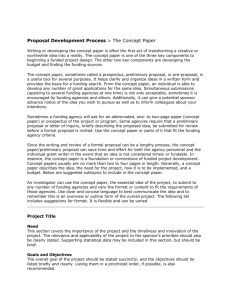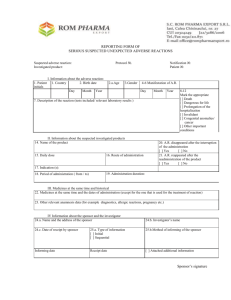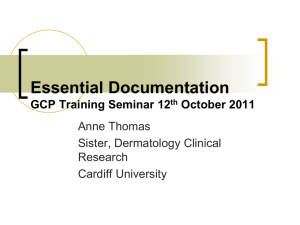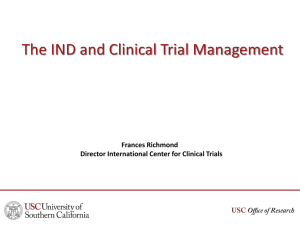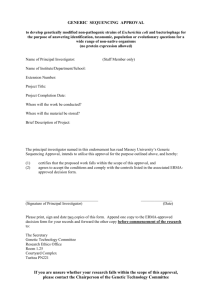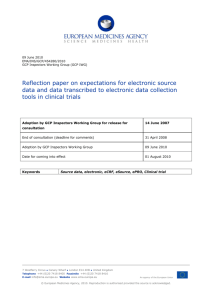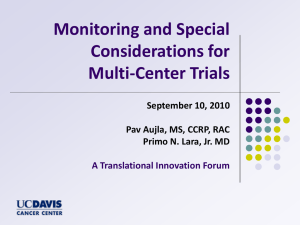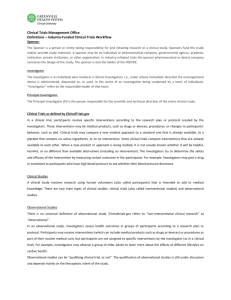reflection paper on expectations for electronic source documents
advertisement
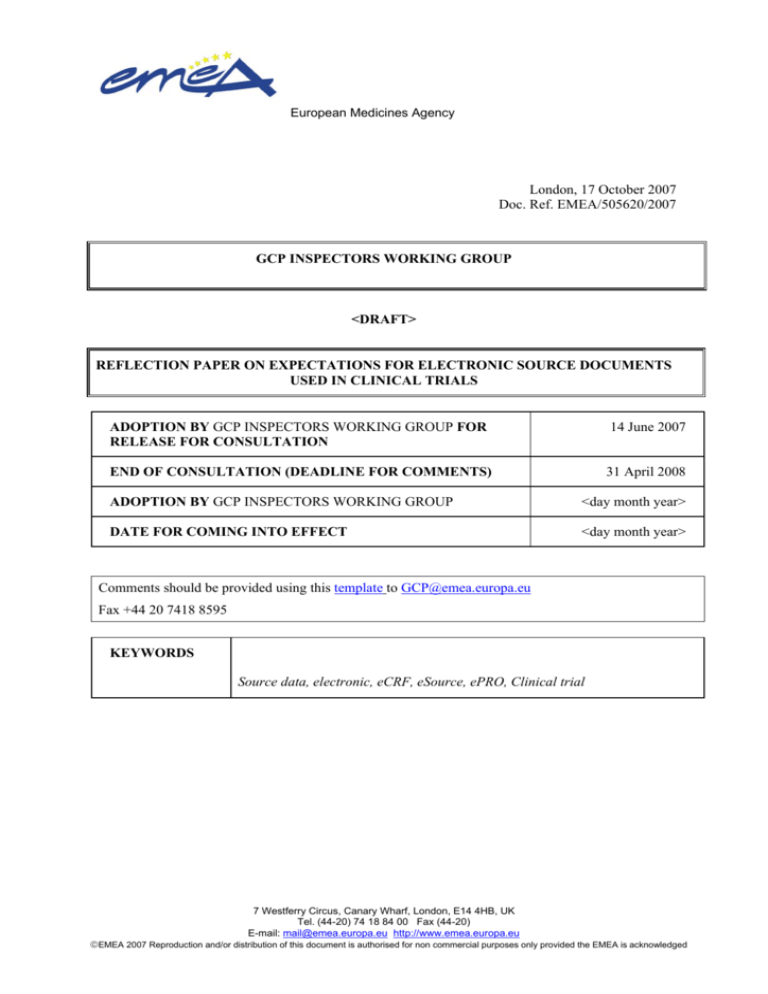
European Medicines Agency London, 17 October 2007 Doc. Ref. EMEA/505620/2007 GCP INSPECTORS WORKING GROUP <DRAFT> REFLECTION PAPER ON EXPECTATIONS FOR ELECTRONIC SOURCE DOCUMENTS USED IN CLINICAL TRIALS ADOPTION BY GCP INSPECTORS WORKING GROUP FOR RELEASE FOR CONSULTATION 14 June 2007 END OF CONSULTATION (DEADLINE FOR COMMENTS) 31 April 2008 ADOPTION BY GCP INSPECTORS WORKING GROUP <day month year> DATE FOR COMING INTO EFFECT <day month year> Comments should be provided using this template to GCP@emea.europa.eu Fax +44 20 7418 8595 KEYWORDS Source data, electronic, eCRF, eSource, ePRO, Clinical trial 7 Westferry Circus, Canary Wharf, London, E14 4HB, UK Tel. (44-20) 74 18 84 00 Fax (44-20) E-mail: mail@emea.europa.eu http://www.emea.europa.eu ©EMEA 2007 Reproduction and/or distribution of this document is authorised for non commercial purposes only provided the EMEA is acknowledged REFLECTION PAPER ON EXPECTATIONS FOR ELECTRONIC SOURCE DOCUMENTS USED IN CLINICAL TRIALS TABLE OF CONTENTS EXECUTIVE SUMMARY................................................................................................................... 3 1. INTRODUCTION ......................................................................................................................... 3 2. SCOPE............................................................................................................................................ 4 3. LEGAL BASIS .............................................................................................................................. 5 4. DEFINITIONS .............................................................................................................................. 5 5. MAIN GUIDELINE TEXT .......................................................................................................... 6 5.1 GENERAL PRINCIPLES ............................................................................................................ 6 5.1.1 Requirements stated in CDISC standard2 on electronic source records........................... 7 6. REFERENCES (SCIENTIFIC AND / OR LEGAL) ............................................................... 10 Page 2/10 ©EMEA 2007 EXECUTIVE SUMMARY Source data and documents form a cornerstone of the approach to record keeping in clinical trials conducted in accordance with Good Clinical Practice. With increasing use of information technology in pharmaceutical development there is a need to have clear guidance on the use of electronic source data and principles that should apply to them. This is necessary in order to ensure that the processes can be used and accepted with confidence when such requirements are complied with, and that the benefits that these systems offer can be fully utilized. This reflection paper sets out the current thinking of the EU GCP Inspectors Working Group on the use of electronic source documents and data in clinical trials and on the inspection of these. Comments on this paper, on the need for further guidance in the area of electronic source data and on the use of computers in clinical trials are sought by 31 April 2008 and should be sent to GCP@emea.europa.eu using this template. 1. INTRODUCTION Computers are being used increasingly in the conduct of clinical trials. This is already a wellestablished practice for data management, analysis and reporting at the sponsor or CRO site. Computers also widely used in laboratories, and are an increasing feature of medical records. They are being used more and more for the capture of clinical data, at the study site, as an electronic (e)CRF, for patient diaries or other forms. These activities use a variety of software and hardware, and in particular several important categories of system – PC, LAN, WAN, laptop, email transmission, web-based systems, Interactive voice response systems (digital phone enabled). The fundamental issues to be demonstrated remain common in many cases to both paper and electronic systems (e.g. traceability, change-control…), though electronic systems present additional challenges in providing an adequate level of confidence in the data. The Note for Guidance on Good Clinical Practice (CPMP/ICH/GCP/135/95)1 sets out many of the basic principles that are needed for the implementation of electronic documentation, although they are mainly described in the context of data collection and transformation. In addition the essential documents required, the responsibilities for these and the applicable retention requirements are stipulated in guidance and in legislation and these requirements are valid for paper and electronic systems. Source data and raw data have traditionally been paper documents. Many requirements and expectations have been developed in this context. The principles underlying these expectations and requirements are largely applicable to electronic media, but their practical application will be different. In addition some of the physical attributes of paper records require rethinking in the context of electronic media. Electronic source records and data can be described in a number of ways. It is important to consider who is providing and controlling the electronic tool being used. Broadly, there are two important groups who may provide these, in the context of clinical trials: Investigators and their institutions, including their laboratories and other technical departments or clinics – they generate the data itself, make the record and may use their own software and hardware (purchased, part of national or institutional health information systems, or locally developed). Sponsors, supplying, and or, managing and operating electronic recording software and instruments and the records generated by them. The sponsors may do this directly or via Page 3/10 ©EMEA 2007 Contract Research Organisations (CROs), the latter often specialised in providing such services (e.g. e-PRO, e-CRF, IVRS etc). Current EU guidance documents and legislation provide some general requirements that apply directly to electronic records and the related processes. Requirements and expectations of paper records will usually also apply to electronic records, but may be implemented differently. Requirements, relating to activities that are recorded in paper records, or requirements for a record to be made, still apply when the activity is recorded by electronic means. The use of electronic records results in new issues as well as a need to reiterate established principles in this new context. The GCP Inspectors Working Group has noted the CDISC (Clinical Data Interchange Standards Consortium) e-SDI Group publication “CDISC Standards and electronic Source Data Within Clinical Trials 20 November 2006”2. In particular the CDISC publication includes a set of twelve user requirements for source data, irrespective of the media or technology used to hold the data. These requirements describe a group of high-level principles, which, if they are adhered to, provide a good basis for the acceptability of source data. These principles should be internationally applicable – an important consideration given the global nature of clinical trials. They provide a good reference for sponsors or investigators establishing such systems, and for monitors and auditors or regulatory inspectors reviewing them. The group has, therefore, chosen to centre this reflection paper around these 12 user requirements, knowing also that they have been prepared on the basis of the ICH GCP1 and other requirements. In this context the reflection paper has repeated these 12 requirements and discusses issues relating to them. This does not imply endorsement of other concepts or details in the CDISC publication2, which contains an extensive discussion of the issues involved, although they may also be valid. When inspecting computer systems, the EU GCP inspectors take into account the publication of the PIC/S – publication SB022 “Inspection of Computer Systems”3. The requirements of Directive 95/46/EEC of the European Parliament and of the Council of 24 October 19954 on the protection of individuals with regard to the processing of personal data and on the free movement of such data need to be followed, in addition to the considerations set out in this paper. Clear requirements for electronic source documents and data need to be stated so that the processes can be used and accepted with confidence when such requirements are complied with, and the benefits that these systems offer can be fully utilised. This paper sets out the considered expectations of GCP inspectors at this time. The GCP Inspection Services Group considers that a reflection on the issues is appropriate and that future guidance may be needed to clarify the requirements and their relationship to the legally defined roles and responsibilities in clinical trials. Comments and feedback on this reflection paper, on the need for further guidance in the area of electronic source data and on the use of computers in clinical trials are sought by 31 April 2008 and should be sent to GCP@emea.eu.int using this template. 2. SCOPE This reflection paper is aimed primarily at the instruments, software and services provided by the sponsors or their contractors. Electronic source documents in this context include: Page 4/10 ©EMEA 2007 Electronic Case Report Forms ((e-CRFs) e.g. laptop/desktop based programs or web based tools which may include a combination of original source records and data transcribed by rekeying from other sources). Electronic patient diaries – e.g. palm-pilot instruments supplied to patients to record observations, rating scales, IMP use – this can be primary efficacy or supportive data. Other instruments supplied to investigators or patients for recording of study data either by data entry or by automated capture of events such as biometric measures (e.g. psychometric scales, blood pressure, respiratory measures, ECG monitoring etc) Instruments and software used for the routine care of the patients and not supplied specifically for the purposes of a clinical trial, electronic medical files of the hospital or clinic and, laboratory instrumentation and diagnostic instrumentation in clinics are not the specific topic of this paper and whilst the principles set out here are also applicable in that context other issues also arise. 3. LEGAL BASIS This document is a Reflection paper (reference to guideline on guidelines) of the GCP Inspection Services Group. The paper is intended to cover the use of electronic source data in clinical trials conducted in the EU/EEA or where clinical trial reports are submitted as part of Marketing Authorisation Applications to EU/EEA regulatory authorities. The requirements have their basis in Directive 2001/20/EC5 and Directive 2005/28/EC6, and in the Recommendation on the content of the trial master file and archiving (July 2006) 7 and in the Note for Guidance on Good Clinical Practice (CPMP/ICH/135/95)1. 4. DEFINITIONS The following definitions are taken from the section 1 (Glossary) of the Note for guidance on Good Clinical Practice (CPMP/ICH/135/95)1: 1.9 Audit Trail Documentation that allows reconstruction of the course of events. 1.11 Case Report Form (CRF) A printed, optical, or electronic document designed to record information to be reported to the sponsor on each trial subject. 1.22 Documentation All records, in any form (including, but not limited to, written, electronic, magnetic, and optical records, and scans, x-rays, and electrocardiograms) that describe or record the methods, conduct, and/or results of a trial, the factors affecting a trial, and the actions taken. 1.51 Source Data All information in original records and certified copies of original records of clinical findings, observations, or other activities in a clinical trial necessary for the reconstruction and evaluation of the trial. Source data are contained in source documents (original records or certified copies). 1.52 Source Documents Page 5/10 ©EMEA 2007 Original documents, data, and records (e.g., hospital records, clinical and office charts, laboratory notes, memoranda, subjects' diaries or evaluation checklists, pharmacy dispensing records, recorded data from automated instruments, copies or transcriptions certified after verification as being accurate copies, microfiches, photographic negatives, microfilm or magnetic media, x-rays, subject files, and records kept at the pharmacy, at the laboratories and at medico-technical departments involved in the clinical trial). 5. MAIN GUIDELINE TEXT 5.1 General Principles The elaboration of general principles to be adhered to is of importance since it allows the preparation of guidance that can then be adapted to the specific situation of a particular electronic data capture instrument or to the context in which it is used. The basic concept of source data is that it permits not only reporting and analysis but also verification at various steps in the process for purposes of confirmation, quality control, audit or inspection. A number of attributes are considered of universal importance to source data and the records that hold that data. These include that the data and records are: • Accurate • Legible • Contemporaneous • Original • Attributable • Complete • Consistent • Enduring • Available when needed Section 5.5 of the Note for Guidance on Good Clinical Practice (CPMP/ICH/GCP/135/95)1 describes standards for the use of electronic trial data handling and/or remote electronic data systems. The GCP requires that sponsors operating such systems validate the system, maintain SOPs for the use of the system, maintain an audit trail of data changes ensuring that there is no deletion of entered data, maintain a security system to protect against unauthorized access, maintain a list of the individuals authorized to make data changes, maintain adequate backup of the data and safeguard the blinding of the study. If data are transformed during processing, it should always be possible to compare the original data and observations with the processed data. The sponsor should use an unambiguous subject identification code that allows identification of all the data reported for each subject. There should be no loss of quality when an electronic system is used in place of a paper system. Page 6/10 ©EMEA 2007 5.1.1 Requirements stated in CDISC standard2 on electronic source records Requirement 1: An instrument used to, capture, source data shall ensure that the data are captured as specified within the protocol. An instrument used to generate, capture, transfer, manipulate or store source data (e.g. Case Report Form (CRF), patient diary, and site-designed worksheet) shall be an accurate representation of the protocol ensuring that the data as specified within the protocol is captured correctly. The process of creating the instrument will need to be validated and controlled to ensure that it conforms to the protocol. The instrument used to capture data should not influence the response. If protocol amendments require changes of the instrument, the implementation of these changes should be described and clearly documented especially if modifications are needed when the instrument is in actual use. Appropriate change control and validation is needed. Records of system, validation specification, installation, testing and controlled release for use should be maintained. Requirement 2: Source data shall be Accurate, Legible, Contemporaneous, Original, Attributable, Complete and Consistent. The use of such systems should ensure that the data are at least as accurate as those recorded by paper means. The validity of the data capture process is fundamental to ensuring that high-quality data is produced as part of a trial. The process needs to ensure that all data required is captured and that the same data are captured in a consistent manner. Completeness and consistency can be assisted through the use of features such as drop-down lists, online edits, check boxes, and branching of questions or data entry fields based on entries. The individual (investigator site staff, and study subjects) capturing the data need to be trained in the accurate use of the instrument and electronic data capture document. The process should ensure that individual entries are legible, usually ensured by the use of electronic entry systems. With data recorded by study subjects, assurance is needed that it has been recorded at the time stated and by the subject. Subject ID and, where different that of the person capturing the data, needs to be recorded accurately. The information should be attributable and this should be assured by the system (login, username, password etc.). Unique user identification is necessary, and this needs to account for the fact that many studies are conducted in multiple locations, and permit entries to be consolidated into a central database. For subject reported source data, assurance is needed that it is the subject entering the data. Electronic checks do not necessarily remove the need for review of data by the investigator or other experts, depending on the nature, purpose and importance of the items involved. Data should be traceable and an unambiguous subject identification code that allows identification of all the data reported for each subject should be used. If data are transformed during processing, it should always be possible to compare the original data and observations with the processed data.. Likewise all data should be retrievable and attributable to a specific subject and, where applicable data capture point (e.g. visit number). Requirement 3: An audit trail shall be maintained as part of the source documents for the original creation and subsequent modification of all source data. The maintenance of an audit trail is important to ensure that the quality of the data is maintained and that changes to the source data are approved and traceable. An audit trail provides evidence that changes made are attributable, date and time stamped, explained and cannot be amended/deleted. Data clarification is part of the process to ensure complete data and the clarification process is one of the processes underlining the need for the maintenance of the audit trail. The audit trail starts with the initial entry of the data. Secure, computer-generated, time-stamped audit trails should be used to independently record the date and time of operator entries and actions that create, modify, or delete Page 7/10 ©EMEA 2007 electronic records. Record changes shall not obscure previously recorded information. Such audit trail documentation shall be retained for a period at least as long as that required for the subject electronic records. Audit trails need to be readable and available. The operators, and responsible investigators and sponsor should review the audit trail at appropriate intervals to monitor any changes to the data. Records of authorisation of access, with levels of access clearly documented e.g. individual user accounts, should be maintained. Audit trails should record changes to data and to access rights. There should be training on the importance of security including the need to protect and not share passwords as well as enforcement of security systems and processes. Security systems should prevent unauthorised access to the computer system and to the data in the electronic record. There should be protection against unauthorised access when a workstation is vacated. There should be timely removal of access no longer required, or no longer permitted. Requirement 4: The storage of source documents shall provide for their ready retrieval. Source documents should always be available to authorised individuals. While a trial is active, existing source data should be readily available to the investigator and others such as monitors. Requirement 5: The investigator shall maintain the original source document or a certified copy. The principle behind this requirement is that the investigator has the source document or a certified copy, thus ensuring protection against changes to the data once it has been passed to another party. Where data is stored on a remote (often central) server without retention of a contemporary local copy, the method by which an investigator or other party retains control of data they have generated should be clearly established, and this control should be demonstrable. This requirement and requirements 6 and 10, in particular, are complementary. Requirement 6: Source data shall only be modified with the knowledge or approval of the investigator. The method by which it is ensured that the investigator knows of and approves of modifications to the data should be clearly established, and this control should be demonstrable. Any changes to the data should be captured by the audit trail (see requirement 3). This includes any modifications arising from data query or clarification processes. The investigator should, usually, have access to review the data on an ongoing basis. Such access should not jeopardise the study blind, where applicable A procedure should be in place to address the situation when a study subject or other operator capturing source data, realises that he/she has made a mistake and wants to make a correction to the recorded source data. Requirement 7: Source documents and data shall be protected from destruction. Source data should be protected from destruction, either accidental or deliberate, and amendments should be made in a controlled fashion. Regular backups should be taken. Suitable archiving systems should be in place to safeguard the data for the periods established by the regulatory requirements including those in any of the regions where the data may be used for regulatory submissions, and not just those of the country where the data is generated. Requirement 8: The source document shall allow for accurate copies to be made. It is a fundamental requirement that a source document can be copied and that there is a practical method of copying of the source document that is complete and accurate, including metadata. It should be possible to print the source document/data for review, audit or inspection purposes. Page 8/10 ©EMEA 2007 Requirement 9: Source documents shall be protected against unauthorized access. Source documents need to be protected so as to maintain subject confidentiality. Changes by unauthorised individuals, either accidental or deliberate, should be prevented. Use of authority checks can ensure that only authorised individuals can use the system. Requirement 10: The sponsor shall not have exclusive control of a source document. This helps to protects against source data being modified in circumstances where it should not be. Where the source data are kept within the control of the investigator until the end of the regulatory retention period, then the requirement can be met. If source data are captured and entered directly into a web-based system without first being captured to paper or other local source and all data are stored in a central server that is not located at the investigator site, the sponsor should not have exclusive control of the source data. This requirement can be achieved by having a copy of the source data retained at the investigator site in addition to the record maintained on a central server. This is not always be achievable. Procedures, system controls and contracts/agreements need to be in place to ensure that the sponsor does not have exclusive control. The sponsor of a study remains ultimately responsible for the quality of the study data and for ensuring that systems and processes are in place to protect this quality. Part of the process involved in achieving this may involve the use of service providers who furnish the hardware and may manage the software and data receipt and storage. The legal framework in the EU and the ICH E6 Note for guidance identifies two entities responsible for the conduct of clinical trials the "sponsor" and the "investigator" (see Directive 2001/20/EC5 and Directive 2005/28/EC6, as well as the Note for guidance on Good Clinical Practice (CPMP/ICH/135/95)1). These two entities carry the legal responsibility for the conduct of the clinical trials, each having a particular set of responsibilities. Both can delegate tasks and functions but each remains ultimately accountable for the assigned responsibilities. The legislation also recognises the existence of CROs as parties to whom the sponsor can subcontract its tasks and functions, but not its ultimate responsibility for the quality of the trial. A service provider collecting or storing data may be a separate legal entity from the sponsor and from the investigator (just like many other service providers), but is still providing a service, on contract, to the sponsor and/or investigator in order to fulfil some of their tasks. The contracts/agreements with the sponsor and with the investigator will need to make clear the role of the service provider and how this relates to the specific responsibilities of the investigator and those of the sponsor. Both these agreements and the processes and systems being used (in particular the software, access controls, audit trail etc) will need to demonstrate how the separation of roles and responsibilities of the investigator and sponsor is achieved, maintained and documented. The data held by these service providers needs to be verifiable as do the processes and proof that the roles and responsibilities for the data are clearly separated between the investigator and sponsor. The investigator has to have access to and control of his site's data. The sponsor should not have exclusive control of the data. Creation, addition, or alteration (including deletion) of the data and reporting of the data to the sponsor are investigator responsibilities. The sponsor role is to monitor, query and ultimately analyse and report on the data. Since these systems and service providers are undertaking activities that have to be delegated by the investigator and by the sponsor, but are provided under contract to the sponsor from a business perspective, there needs to be a clear agreement between the sponsor, investigator and service provider establishing the tasks of each party and their responsibilities and clarifying how this is implemented. Requirement 11: The location of source documents and the associated source data shall be clearly identified at all points within the capture process. The process of transferring or copying data raises the question of which is the source data. There is a need, where data are to be copied or transferred, that the location and identification of the source data, and the points when such data are copied are well documented and understood. There should only be one source at any time (not including back-ups which may be required). . Where more than one copy exists there should be a clear definition of which is considered the reference should differences emerge. Any change of location of the source data needs to be visible to all concerned. Page 9/10 ©EMEA 2007 Requirement 12: When source data are copied, the process used shall ensure that the copy is an exact copy preserving all of the data and metadata of the original. There is a need to define what an accurate copy is in an electronic sense. Accurate copies should include the meaning of the data (for example date formats), as well as the full audit trail. The investigator site should usually have the possibility of reviewing the data and generating copies. Where certified copies are made, the process for certification should be described, including the process for ensuring that the copy is complete and accurate and for identifying the certifying party and their authority for making that copy. 6. REFERENCES (SCIENTIFIC AND / OR LEGAL) 1. Note for Guidance on Good Clinical Practice (CPMP/ICH/135/95) Volume 3C Efficacy, Rules Governing Medicinal Products in the European Union. 2. CDISC e-source standard requirements-CDISC (Clinical Data Interchange Standards Consortium) Version 1.0 20 November 2006. 3. INS-GCP-3 Annex III to Procedure for conducting GCP inspection requested by the EMEAComputerised Systems http://www.emea.europa.eu/Inspections/GCPproc.html 4. Directive 95/46/EC of the European Parliament and of the Council of 24 October 1995 on the protection of individuals with regard to the processing of personal data and on the free movement of such data (Official Journal L 281, 23.11.1995, p. 31–50). 5. Directive 2001/20/EC OF the European Parliament and of the Council of 4 April 2001 on the approximation of the laws, regulations and administrative provisions of the Member States relating to the implementation of good clinical practice in the conduct of clinical trials on medicinal products for human use (Official Journal L 121, 1/5/2001 p. 34 - 44). 6. Commission Directive 2005/28/EC of 8 April 2005 laying down principles and detailed guidelines for good clinical practice as regards investigational medicinal products for human use, as well as the requirements for authorisation of the manufacturing or importation of such products (Official Journal L 91, 9/4/2005 p. 13 - 19). 7. Recommendation on the content of the trial master file and archiving (July 2006) Chapter V, Volume 10, Rules Governing Medicinal Products in the European Union. Page 10/10 ©EMEA 2007

